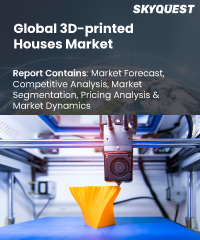
Report ID: SQMIG20G2034

Report ID:
SQMIG20G2034 |
Region:
Global |
Published Date: February, 2024
Pages:
157
|
Tables:
64 |
Figures:
75
3D-printed Houses Market Drivers
Cost-Effective and Sustainable Construction
Advancements in 3D Printing Technology
3D-printed Houses Market Restraints
Building Codes and Regulations
High Initial Costs
Our industry expert will work with you to provide you with customized data in a short amount of time.
REQUEST FREE CUSTOMIZATIONWant to customize this report? This report can be personalized according to your needs. Our analysts and industry experts will work directly with you to understand your requirements and provide you with customized data in a short amount of time. We offer $1000 worth of FREE customization at the time of purchase.

Report ID: SQMIG20G2034